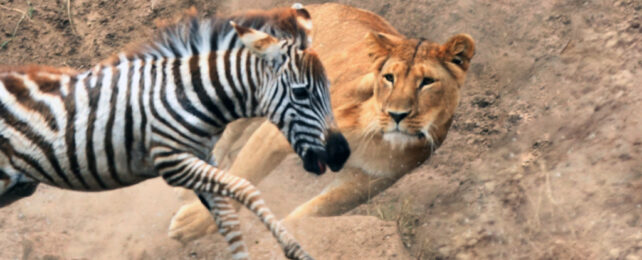In a stark example of how everything on our living planet is interconnected, one species of tiny, invasive insects has reduced lions' abilities to feast on zebras.
As we humans are causing so many different changes to our environment all at once, it's not always easy to pin the consequence on the disturbance that produced it.
So University of Wyoming zoologist Douglas Kamaru and colleagues performed a series of experiments to untangle the mess of species interactions on Kenya's savanna to discover an outsized impact a mere ant is having on the ecosystem's top predator.
Invasive big-headed ants (Pheidole megacephala) have hitched a ride with us from a Pacific island to many continents, including Africa, likely travelling by potted plant.
The researchers compared areas of the savannah that had been invaded by big-headed ants to places these ants had yet to reach. The untouched areas had substantially more tree cover.
In the areas with fewer trees, lions (Panthera leo) had less cover from which to ambush zebras (Equus quagga) from, leading to almost three times as many zebras escaping from the big cat's grasp.
These kind of interdependencies that cross different levels of a food chain are called trophic cascades.
There is some evidence lions may be switching to relying on other prey as a consequence, the researchers explain.
As whistling thorn tree coverage declined, zebra kills by lions dropped from 67 to 42 percent, while buffalo kills rose from 0 to 42 percent between 2003 to 2020. But it's too early to know the full ramifications of lions' increasing difficulties hunting zebras.
So how do ants impact tree coverage?
Such connections are often hard to see, even in well-studied ecosystems, so we often don't realize they're there until we've hacked them apart and are met with the consequences.
It turns out the trees missing from the invasive ants territory, the whistling thorn trees (Vachellia drepanolobium) have a mutually beneficial relationship with the local acacia ants (Crematogaster sp.). The trees provide the ants with food and shelter and in turn the ants aggressively protect the trees from their biggest predator: hungry elephants.
But the invasive ants, who live underground, slaughter the native species and feast on their eggs, larvae and pupae. So without the dissuasive stings of acacia ants on the whistling thorns, elephants are free to browse and break the trees up to seven times more in the invasive ants' territory.
"By controlling biophysical structure across landscapes, a tiny invader reconfigured predator-prey dynamics among iconic species," the researchers explain in their paper.
This demonstrates how critical species interactions do not necessarily always involve the food chain. Other kinds of relationships between species, like the symbiotic mutualism between ants and trees can be just as significant.
These interdependencies are more important to understand than ever, seeing as the many disturbances we humans are creating are rapidly unraveling complex systems of interactions that form a functioning ecosystem – from relocating invasive species to the mere sound of our voices everywhere.
"In an era characterized by rapid environmental change, such applied ecological research is critical to understand how disturbance alters ecosystem structure and function," says University of British Columbia zoologist Kaitlyn Gaynor in an accompanying commentary on the paper.
"Ultimately, the conservation of healthy ecosystems requires not only the prevention of species extinction but also the identification and preservation of the most important interactions among species."
This research was published in Science Advances.
